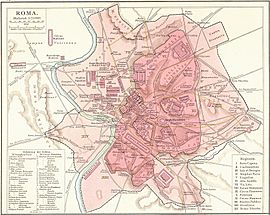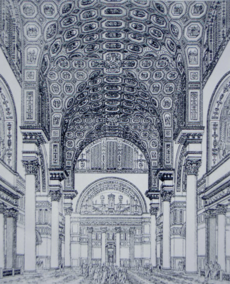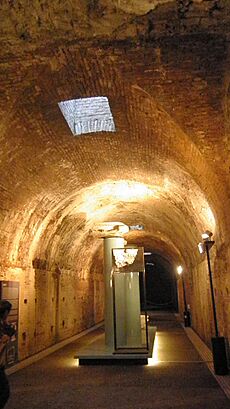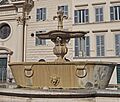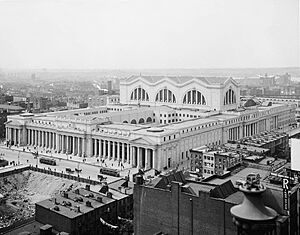Baths of Caracalla facts for kids
|
Latin: Thermae Antoninianae
|
|
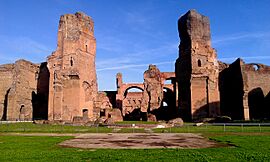
The baths as viewed from the south-west. The caldarium would have been in the front of the image
|
|
| Alternative name | Italian: Terme di Caracalla |
|---|---|
| Location | Rome, Italy |
| Region | Regio XII Piscina Publica |
| Coordinates | 41°52′46″N 12°29′35″E / 41.87944°N 12.49306°E |
| Type | Thermae |
| Part of | Ancient Rome |
| Area | 100,000 m2 (1,100,000 sq ft) |
| Volume | 8,000,000 L (1,800,000 imp gal; 2,100,000 US gal) (baths' waters) |
| Height | 40 m (130 ft) |
| History | |
| Builder | Caracalla |
| Material | Marble, pozzolana, lime, tuff, basalt |
| Founded | probably 212-216/217 AD |
| Abandoned | circa 537 AD |
| Periods | Imperial |
| Site notes | |
| Condition | in ruins |
| Public access | Limited |
| Architecture | |
| Architectural styles | Ancient Roman |
| Official name | Baths of Caracalla |
| Type | Cultural, artistic, historical, architectural, religious |
| Criteria | i, ii, iii, iv, |
| Historic Centre of Rome... | |
| List of ancient monuments in Rome |
|
The Baths of Caracalla (also known as Terme di Caracalla) were huge public baths in Rome, Italy. They were the second largest Roman public baths ever built. These amazing baths were constructed between AD 212 and 217, during the time of emperors Septimius Severus and his son, Caracalla.
For over 300 years, the Baths of Caracalla were a busy place. People came to bathe, exercise, read, and socialize. They were used until the 530s AD, when they eventually fell into disuse and became ruins.
Even today, the Baths of Caracalla inspire architects and artists. Many famous buildings, both old and new, have been designed with ideas from these baths. Some famous sculptures, like the Farnese Bull and the Farnese Hercules, were found here. Today, the ruins are a popular tourist attraction in Rome.
Contents
History of the Baths
How Were the Baths Built?
The construction of the Baths of Caracalla began under Emperor Septimius Severus. His son, Emperor Caracalla, finished the project. The baths officially opened in AD 216. They were built in the southern part of Rome, a special area where the Severan family built other important structures.
The land chosen for the baths used to be a large garden estate. This estate belonged to a man named Gaius Asinius Pollio. To build the baths, Caracalla took over this land. Older buildings on the site were torn down or filled in to create a strong foundation for the new bath complex.
Building such a massive structure was a huge task. Workers had to move over 2,000 tons of material every single day for six years! This shows how much effort went into creating these impressive baths.
Work on the decorations continued even after Caracalla's reign. Later emperors like Elagabalus and Severus Alexander added more details. The baths were mostly finished by AD 235. They were heated by a system called a hypocaust. This system burned coal and wood under the floors to heat the water. The baths were free for everyone to use.
What Happened to the Baths?
The Baths of Caracalla were very important in the 5th century. People even called them one of the seven wonders of Rome. It's believed that up to 1,600 people could use the baths at the same time. Each day, between 6,000 and 8,000 bathers might have visited.
The baths were used until the 6th century. In 537 AD, during a war, the city's water supply was cut off. This meant the baths could no longer get water, so they were abandoned. Since they were far from the main part of Rome, they fell into disuse. Some simple tombs were even found inside the bath area from this time.
An earthquake in 847 AD caused a lot of damage to the building. After this, people started using the baths as a quarry. This means they took stones and decorative pieces from the ruins to build new churches and palaces in other cities.
How Were the Baths Used Later?
By the 14th century, the area around the baths was used for vineyards and gardens. In the 15th century, Pope Pius II used stones from the baths to help build St. Peter's Basilica. Later, Pope Clement VII allowed people to take columns, marble, and other materials from the baths for new buildings.
In the mid-16th century, Pope Paul III started excavations at the site. During these digs, many large marble and bronze statues were found. So many items were discovered that a museum was created to hold them! The area was then given to the Roman Seminary of the Jesuits and even used as a playground for children.
Interest in the ruins grew again between the 16th and 18th centuries. Many famous architects drew pictures of the baths. The aqueduct that brought water to the baths was actually still used up until the 19th century.
Discovering and Restoring the Ruins
In 1824, excavations at the baths began. Mosaics showing athletes were found, and they are now in the Vatican Museums. More work continued through the 19th century, revealing more parts of the complex.
In 1870, the Italian government took ownership of the site. More mosaics were discovered in different parts of the baths. In the early 20th century, excavations went deeper, uncovering underground passages and even a Mithraeum, which was a special meeting place for followers of the Persian god Mithra.
In the 1980s, more restoration work took place. Overgrown plants and illegally built houses were cleared away. Parts of the walls, libraries, and halls were repaired. In 1998-99, a modern stage for performances was added, and the baths reopened to the public in 2001.
The baths have faced some challenges, like minor damage from earthquakes in 2009 and 2016.
What Did the Baths Look Like?
The entire bath complex was huge, covering about 25 hectares (about 62 acres). It was shaped like a rectangle, measuring 337 meters (1,106 feet) by 328 meters (1,076 feet). Building it required moving a massive amount of earth. Millions of bricks were used, and there were at least 252 columns, some over 12 meters (39 feet) tall!
Water came from a special aqueduct called the Acqua Antoniniana. This aqueduct connected to 18 large cisterns (water tanks) on the southern side of the baths. Lead pipes then carried the water from these cisterns into the bath buildings.
The Baths of Caracalla were more than just a place to bathe. They were a complete leisure center. Besides bathing, people could walk, read, study, exercise, and get body care. The main building was in the center, surrounded by outer walls. These walls held the water tanks, two libraries, large open halls (exedras), and shops. Between the outer wall and the central building were beautiful gardens.
The baths were built facing northeast to southwest. This helped them use the sun's heat to warm the rooms. The hot room (caldarium) faced southwest, and the cold room (frigidarium) faced northeast. The main bath building was 214 meters (702 feet) by 110 meters (361 feet) and stood 44 meters (145 feet) high. It could hold an estimated 1,600 bathers at once.
Inside the Baths
The Baths of Caracalla were one of the first public baths to have a library inside. Like other Roman public libraries, it had two separate rooms. One room was for Greek language texts, and the other was for Latin texts. The surviving library had walls with niches (small alcoves) where books were stored.
The main parts of the baths included:
- A central frigidarium (cold room): This huge room was 58 meters (190 feet) by 24 meters (79 feet). It had a high roof supported by eight giant columns made of Egyptian granite. This room was a meeting place and had four cold pools.
- A double pool tepidarium (medium room): This room had two pools with medium-temperature water.
- A circular caldarium (hot room): This room was 35 meters (115 feet) in diameter and had a dome almost as big as the Pantheon's dome. It had seven hot pools. Glass windows helped heat the room.
- Two palaestras (gyms): These were areas where people practiced wrestling and boxing.
- A natatio (swimming pool): This Olympic-sized pool was 50 meters (164 feet) by 22 meters (72 feet). It was open to the sky, and bronze mirrors were used to direct sunlight into the pool area.
The entire bath building was built on a raised platform, about 6 meters (20 feet) high. This allowed space for storage and furnaces underneath the building.
Secret Tunnels and Rooms Below
Underneath the baths, there was a network of tunnels. In 1912, a large Mithraeum was discovered. This was a secret meeting place for followers of Mithra, a Persian god popular with soldiers. This Mithraeum was about 23 meters (75 feet) long and 10 meters (33 feet) wide. It had benches along the walls and a mosaic floor.
One interesting feature in the Mithraeum was a circular pit. Some experts believe this was a fossa sanguinis, a ritual pit where a bull might have been sacrificed. Others think it was a trap door for a dramatic entrance.
These tunnels weren't just for secret meetings. They also helped heat the baths and served as sewers for the water. They were used to store the huge amount of wood needed for the furnaces – about 10 tons of wood per day! The tunnels were lit by skylights to keep the wood from rotting.
An underground water mill was also found. It might have been part of the original bath system.
How Big Were They?
Here are some of the main measurements of the Baths of Caracalla:
- The entire area of the complex was about 412 meters (1,352 feet) by 393 meters (1,289 feet).
- The central bath building was 214 meters (702 feet) by 110 meters (361 feet).
- The swimming pool (natatio) was 54 meters (177 feet) by 23 meters (75 feet).
- The cold room (frigidarium) was 59 meters (194 feet) by 24 meters (79 feet) and 41 meters (135 feet) high.
- The hot room (caldarium) was 35 meters (115 feet) in diameter and 44 meters (145 feet) high.
Building the baths required a lot of materials:
- Over 341,000 cubic meters of pozzolana (a type of volcanic ash used in concrete).
- 35,000 cubic meters of lime.
- 341,000 cubic meters of tuff (a type of rock).
- 150,000 cubic meters of basalt for the foundations.
- 17.5 million brick pieces for facing.
- 252 marble columns in the central block.
It's estimated that thousands of men worked on the baths every day. For example, about 5,200 men worked on excavations, and 9,500 men built the substructure. The large granite columns in the frigidarium weighed almost 100 tons each!
Amazing Artworks Found Here
The Baths of Caracalla were originally decorated with over 120 high-quality sculptures. Even though the baths were in a working-class area, they had the most lavish collection of statues of all ancient Roman baths.
Many sculptures were destroyed over time, but starting in the 16th century, new excavations began. Famous pieces found at the baths include the Farnese Bull and Farnese Hercules. These are now in the Naples National Archaeological Museum. Another huge statue found was a 4-meter (13-foot) tall statue of Asclepius, the god of medicine.
Two large granite tubs from the frigidarium were moved to Piazza Farnese in Rome, where they are now used as beautiful fountains. A granite column from the natatio was taken to Florence and is now known as the Column of Justice. Mosaics showing athletes, discovered in 1824, are now displayed in the Vatican Museums.
How the Baths Influenced Other Buildings
The design of the Baths of Caracalla, especially the central frigidarium, had a big impact on many later buildings. In Roman times, the Baths of Diocletian and the Basilica of Maxentius were inspired by them.
In the 19th and early 20th centuries, the baths' design was used as inspiration for several modern structures. These include St George's Hall in Liverpool, the original Pennsylvania Station in New York City, and the current Senate of Canada Building in Ottawa. The main halls of these buildings directly copied the architecture of the frigidarium.
The Baths Today: A Cultural Venue
Opera and Concerts
From 1937 to 1993, the central part of the bath complex (the caldarium) was the summer home for the Rome Opera company. Opera performances started again in 2001, but now they use a temporary stage outside the main structure. This helps protect the ancient ruins.
The baths are also a popular concert venue. They became famous as the backdrop for the first Three Tenors concert in 1990.
Sporting Events
The area around the baths was used for the Rome Grand Prix car race four times between 1947 and 1951.
During the 1960 Summer Olympics in Rome, the baths hosted the gymnastics events.
Film Location
The Baths of Caracalla were even used as a filming location for the movie John Wick: Chapter 2.
Visiting the Baths
The large ruins of the Baths of Caracalla are a popular tourist attraction today. They are open to the public, but you need to pay an admission fee. Visitors can only access certain areas and walkways. This helps protect the delicate mosaic floors and other ancient structures from further damage.
See also
- Baths of Diocletian
- List of Roman public baths


